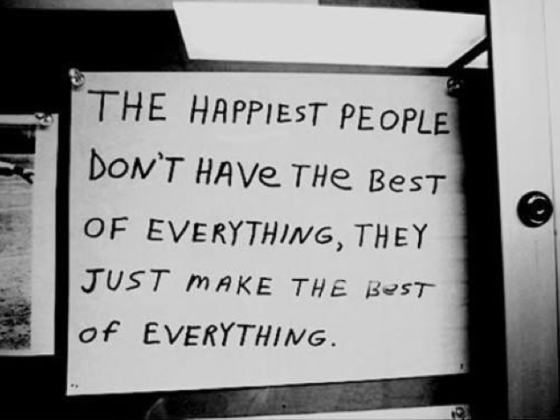Category Archives: Article
Track Your Happiness
Have you heard about Track Your Happiness.org? This website is part of a new scientific research project that investigates “what makes life worth living”. Using the site people are able to track their happiness by identifying factors that, for them, are associated with greater happiness.
How it works:
1.Answer a few questions .
First they’ll ask you some questions for statistical purposes. This will take about 10 minutes.
2.Track your happiness
Using your iPhone, you’ll be notified by email or text message and asked to report how you are feeling and what you are doing. You decide when and how often you want to be notified.
3. Your Happiness Report
This report will show how your happiness varies depending on what you are doing, who you are with, where you are, what time of day it is, and a variety of other factors.
Get tracking!
Happiness Tip of the Day
According to Professor Willibald Ruch of the University of Zurich people who focus on utilizing their strengths in their everyday lives experience more happiness than people who focus their attention on what they think they need to change about themselves. To identify your strong suits Ruch suggests you take a free assessment developed by psychologists called: the Values in Action Inventory of Strengths Survey. This test helps to identify an individual’s strongest qualities, such as creativity or perseverance. So today, take the test and instead of focusing on what you think you can fix about yourself, focus on what is already great about yourself–trust me, there’s plenty!
The Happiest People
Minimalist Drawings That Will Make You Smile
Minimalist drawings by Jaco Haasbroek, a designer and illustrator from Cape Town, South Africa.
The Happiest Country In the World
According to the World Happiness Report (a 156 page report) published by the Earth Institute at Columbia University, the happiest countries are all in Northern Europe. They include: Denmark, Norway, Switzerland, the Netherlands and Sweden. Amazingly, Denmark has topped the table every year since 1973 (Denmark.dk).
So why are the Danes consistently ranked the happiest people in the world? There may not be one right answer to this, but Professor of Economics Christian Bjørnskov from the Aarhus Business School in Denmark may be able to offer some insight into this topic.
“Professor…Christian Bjørnskov…knows all about happiness, he even wrote his PhD on the subject. ‘The happiness surveys normally ask people to evaluate their lives. Research show what makes the Danes so happy is that they are very trusting of other people they don’t know. Trust helps make people happy. Also just as importantly, Danes feel empowered to be able to change something in their life if they don’t like it,’ he says.
‘The great thing about Danish society is that it doesn’t judge other people’s lives. It allows them to choose the kind of life they want to live, which is sometimes not always possible in other countries, so this helps add to the overall satisfaction of people living here,’ he adds.
It also seems the Danes attitude to money is refreshing different from other countries. ‘Money is not as important in the social life here, as for example Britain and America. We probably spend our money differently here. We don’t buy big houses or big cars, we like to spend our money on socialising with others,’ concludes the Professor.”
I spent four months in Denmark in the spring of 2013. Upon my arrival I was determined to figure out what made Denmark “the happiest country in the world”. Was it all the biking? Were all those endorphins helping? Was it the colorful buildings I always saw in pictures? Was it the pastries? It had to be the pastries…right? In the end, I can’t say that I ever figured out exactly what makes the Danes happier then the rest of us. But, I think the answer lies in the way that the Danes conceive of and define happiness. While I was in Denmark I found that the Danes did not live their lives with the same sense of urgency as we do in the United States. There was not the same pressure to graduate high school, go straight to college, and then to find a job. Most Danes I met took time off before college to work and travel and figure out what they wanted to do with their lives. I use to look at happiness as an objective emotion. I thought that in its most basic form it had to like smiling: it had to be universal. But the more I have examined happiness the more I have realized that it is and always has been changing. Happiness differs across time periods, and across cultures–in fact, there are books and essays written on about all of the ways in which happiness is perceived by different people. For example, back in Ancient Greece happiness was “deemed as something beyond human agency, controlled mainly by luck and the gods” (Oishi 4). Happiness was not something people had control over.
So while it definitely seems that we could all learn a thing or two from the Danes such as: learning to spend our money on experiences vs. material objects and learning to realize we can change the aspects of our life we don’t like, there is something to be said about accepting different types of happiness. And, in my opinion, there is nothing wrong with finding your own way to happiness. Plus, Denmark is a small country, we could try, but let’s face it…we all won’t fit.
Is Happiness Built on These Four Pillars?
According to the Mayo Clinic people who are happy seem to intuitively know that their “happiness is the sum of their life choices”, and their lives are built on the following pillars:
- Devoting time to family and friends
- Appreciating what they have
- Maintaining an optimistic outlook
- Feeling a sense of purpose
What are you using for the basis of your happiness? If it is different from these four pillars, it is not necessarily wrong, but keep in mind that any strong structure needs a good foundation!





